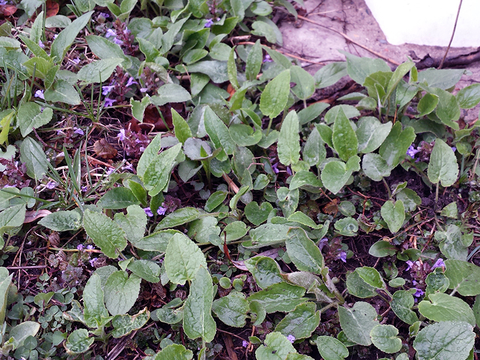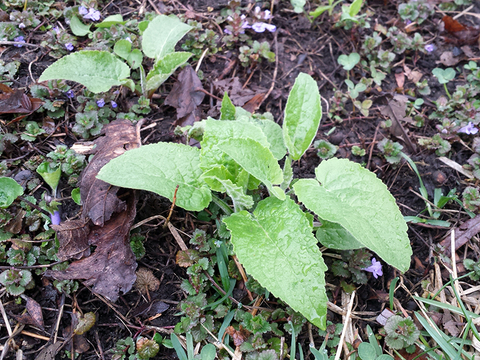Quick facts
- Creeping bellflower is invasive in Minnesota and spreads by seed dispersal and root propagation.
- Bell-shaped, blue-purple flowers grow up one side of creeping bellflower stalks and carry up to 15,000 seeds.
- Small sections of creeping bellflower can be managed by removing all of the plant’s roots; repeated removal may be necessary.
- Broadleaf herbicides may be effective on large infestations, but creeping bellflower is resistant to many herbicides.
Characteristics
Creeping bellflower (Campanula rapunculoides), also known as European bellflower and rampion, is an invasive perennial plant and member of the Campanulaceae (bellflower) family.
Growing between 2-3 feet tall, creeping bellflower outcompetes other species and requires dedicated removal efforts as it spreads by both seed and roots.
Flowers, fruit and seeds
- Bloom time: summer to early fall.
- Creeping bellflowers have bell-shaped, blue-purple flowers with five pointed lobes that grow primarily along one side of a flower stalk, growing 2-3 feet tall.
- Multiple flowering stems.
- After flowering, creeping bellflower produces up to 15,000 seeds per plant.
Leaves
- Leaves at the base of the plant are heart-shaped but become shorter and narrower (lance-shaped) moving up the plant stem.
- Leaves alternate with slightly hairy undersides and coarse-toothed edges.
Stem and roots
- Stems are green or purple and contain a milky sap when broken.
- Forms extensive root systems with a combination of large, tuber-like storage roots, horizontal rhizomes, and small, thin roots.
- Rapunculoides derives from rapunculus, meaning “little turnip” in Latin
- New plants can form from small root pieces in the soil.
Where it thrives
Creeping bellflower thrives in disturbed soils and prefers to establish in moist garden sites, although due to its high adaptability, it can thrive in most environments.
Root systems of creeping bellflowers out-compete nearby plants by choking them out. Small pieces of roots can form new plants.
Control and management
Creeping bellflower is an aggressive weed that can be managed in several ways.
Although more commonly found in gardens, creeping bellflower also can grow in large patches in lawns, but it will not flower if mowed regularly.
Pulled creeping bellflower plants should be burned or bagged and allowed to decompose to minimize their aggressive spread via seeds and rhizomes.
Lawn
- Hand removal is effective for removing small patches but may need to be repeated.
- Remove all parts of the roots and shoots to prevent regrowth.
- A dense and healthy turf is the best defense against creeping bellflower encroachment.
- Chemical control is most effective in the fall. If needed, spring application is also effective.
- Clopyralid is the best herbicide for selective post-emergent control, although it can be hard to find.
- Dicamba and triclopyr provide some selective post-emergent efficacy but need higher doses and repeated use.
- Glyphosate is a non-selective herbicide that will require sequential applications for control.
- 2,4-D and Quinclorac are ineffective.
Garden
- Hand removal is effective for removing small patches but may need to be repeated.
- Remove all parts of the roots and shoots to prevent regrowth.
- Smothering the plant with a tarp or newspaper can effectively minimize creeping bellflower.
- Broadleaf herbicides can be effective on large patches with repeat applications, but creeping bellflower has shown resistance to many herbicides.
- Clopyralid is a great selective post-emergent herbicide but can be hard to find.
- Dicamba and triclopyr also work selectively but need higher doses and repeated use.
- Glyphosate is a non-selective herbicide, so multiple treatments are needed.
- 2,4-D and Quinclorac are not effective.
- Be cautious as broadleaf herbicides can harm desired garden plants.
Benefits to the landscape
Creeping bellflower benefits some native bees and insects, but it out-competes plant species that are more beneficial to pollinators.
Native bellflower species, such as American bellflower (Campanula americana), can be grown to replace pollen sources for bellflower-specific pollinator species.
Creeping bellflower has also been used as an edible plant by many well-known foragers, such as the Forager Chef.
Conservation, invasive status and native status
- Invasive.
- Introduced.
- Creeping bellflower is native to parts of Europe and Asia.
- It was likely introduced to the United States as an ornamental plant.
Plants that look similar
- Violets
- Heal-all
- Harebell (Campanula rotundifolia)
CAUTION: Mention of a pesticide or use of a pesticide label is for educational purposes only. Always follow the pesticide label directions attached to the pesticide container you are using. Be sure that the area you wish to treat is listed on the label of the pesticide you intend to use. Remember, the label is the law.
Creeping Bellflower. Wisconsin Department Natural Resources - Invasives. https://dnr.wisconsin.gov/topic/Invasives/fact/CreepingBellflower
Reviewed in 2024



